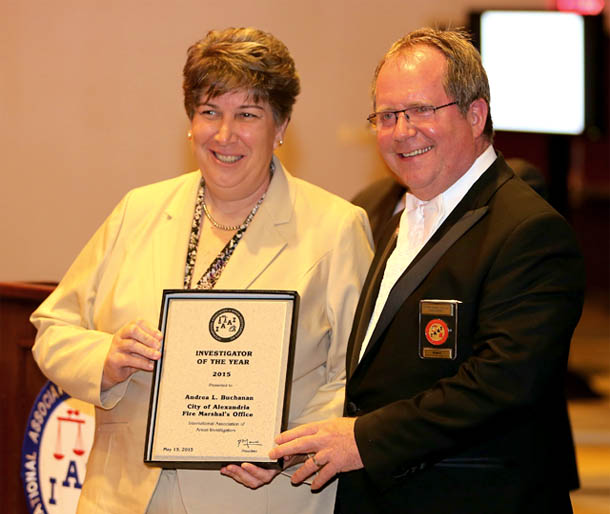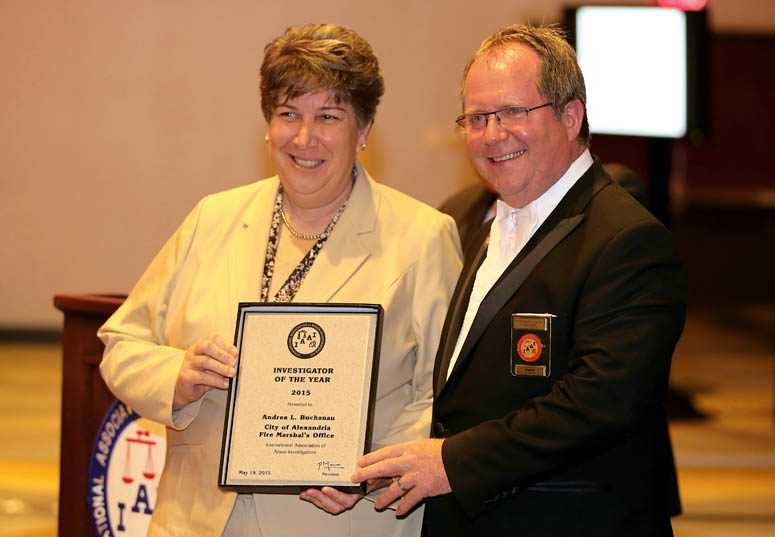On June 5, 2013 Assistant Fire Marshal, Andrea Buchanan of the Alexandria (VA) Fire Department was called to a 16-story apartment building to investigate several small fires on different floors. The fires were all small and seemingly unimportant, except to AFM Buchanan. She saw the work of a serial arsonist. From her training, she knew that these small fires would escalate. She also knew that she had a rare opportunity – she was seeing the work of a serial arsonist at the beginning, whereas most serial arson cases aren't taken seriously until there is a major fire or loss of life. The building housed 1500 people, including young families and the elderly. There was no fire sprinkler system. The fire alarm system could only be activated manually. The potential for disaster was high. But, not everyone would see it that way.
That first night, AFM Buchanan coordinated surveillance of the building. While she and her investigative partner were interviewing persons of interest, more fires were started in the building, including one that happened 50 feet from where AFM Buchanan was interviewing a witness. But, with thousands of possible suspects and no surveillance cameras in the concrete building, there was no arrest that night.


2015 IAAI Fire Investigator of the Year: Assistant Fire Marshal Andrea Buchanan
AFM Buchanan immediately brought her concerns to her fellow fire marshals and requested assistance from the local field office of the Bureau of Alcohol, Tobacco, Firearms and Explosives. Over the next several months, dozens of small fires were set in the building. Each fire seemed insignificant – trash piles, pamphlets on bulletin boards – just an annoyance to residents, nothing scary. AFM Buchanan responded to every fire, documenting it, interviewing witnesses. She worked with ATF to continue the investigation and conduct surveillance. But, her requests to the fire and police departments for dedicated personnel to work the investigation went unanswered. The perception was that these were "just trash fires" and not worth the time and effort. There was even a plan to lay off half of her fire marshals to save money.
As the investigation stretched into the winter, the inevitable escalation AFM Buchanan knew was coming occurred. On December 6, 2013, someone set fire to a large refrigerator box full of packing material in the hallway on the 7th floor. The fire filled the floor with thick smoke and caused $50,000 in damage. Now, residents were afraid. Now, the fire and police departments were paying attention. But, AFM Buchanan's concerns and effort weren't acknowledged and affirmed; instead, her competence was questioned because she hadn't yet solved the case, even though she was denied resources that would have likely hastened an arrest. A power struggle for control of the investigation ensued, but AFM Buchanan remained resolute.
Throughout several months of investigation, AFM Buchanan was submitting data on the fires to the Bomb and Arson Tracking System (BATS). The ATF Bomb Data Center, which monitors BATS activity, contacted AFM Buchanan. Based on data analysis, the Bomb Data Center had identified a pattern. They were able to narrow down the days of the week and times of day that the fires were most often set. They also identified the three most-likely floors where fires occurred. This gave AFM Buchanan the opportunity to target those floors by installing hidden cameras.
After convincing building management of the need for the cameras in secret locations, cameras were installed on the three target floors, including the 7th floor where the large December fire occurred. Several weeks later, a new fire happened on the 7th floor, but the perpetrator was out of the field of view of the camera. A new camera was installed, but it failed to record the next fire. On the third try, the camera caught the arsonist in the act. She was a 72-year-old woman who lived on the 7th floor. She was arrested, confessed to setting dozens of fires to "relieve stress." She stated that a building power outage for maintenance that was going to occur the next day was particularly stressful for her. If she had set a fire during that outage, no power and no fire protection system could have spelled disaster. She pleaded guilty to arson of an occupied building, but was given only a suspended sentence and probation. She walked out of court free.
Often, investigators are praised for their efforts when they solve "big cases"– ones where lives are lost, or property catastrophically destroyed. AFM Buchanan's work in this case averted tragedy, saving who knows how many lives in that high-rise building and among the firefighters who would have had to respond to the inevitable large blaze. She saw the opportunity to catch a serial arsonist before the escalation killed someone; an opportunity that is rare because investigators too often don't see it when they work those small, seemingly insignificant trash fires. No fire set by human hands is insignificant, and AFM Buchanan's solid, tireless work in this case is testimony to that fact.
For her work in this case, Assistant Fire Marshal Andrea Buchanan of the Alexandria (VA) Fire Department received the IAAI's Investigator of the Year Award for 2015.